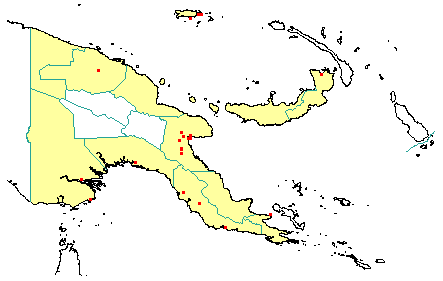
in PNGplants database
PNGTreesKey – Ganophyllum falcatum Blume |
Barry Conn (NSW) & Kipiro Damas (LAE).
Guide to trees of Papua New Guinea
Copyright held by the authors, National Herbarium of New South Wales, and Papua New Guinea National Herbarium
Museum Botanicum Lugduno-Batavum sive stirpium Exoticarum, Novarum vel Minus Cognitarum ex Vivis aut Siccis Brevis Expositio et Descriptio Vol. 1: 230 (1850)
Other Literature: P.W. Leenhouts, Flora Malesiana, Series 1 538-540 (1994) Fig. 29.
Family: Sapindaceae
Dicotyledon
Timber Group: Commercial hardwood
Field Characters: Emergent tree or Large canopy tree (up to 40 m high, sometimes to 50 m); Bole cylindrical (80-95 cm diam.); straight (bole 20-45 m long); buttresses buttresses present or buttresses absent; spines spines absent; aerial roots aerial roots absent; stilt roots stilt roots absent; Bark grey, dark brown, or slightly black, rough, scaly or flaky; Subrhytidome (under-bark) pale red or brown (pinkish brown); less than 25 mm thick, 10.0; bark blaze with two layers; strongly aromatic; unpleasant; outer blaze pale brown, markings absent, fibrous; inner blaze slightly white, pink, or brown (yellowish (straw-coloured), markings absent, fibrous; bark exudate (sap) present, colourless, not readily flowing (spotty), colour not changing on exposure to air, not sticky; terminal buds not enclosed by leaves.
Indumentum: Complex hairs absent; stinging hairs absent; mature twig indumentum (hairs) absent.
Leaves: Leaves spaced along branches, spiral (leaves occurring singly at a node and arranged spirally up the branchlet), compound (a leaf made up from two or more leaflets); petiole present, not winged, attached to base of leaf blade, not swollen; leaves pinnate (unbranched with more than three leaflets) (mostly with 5-8 leaflets); petiolule not swollen or swollen (slightly (at base); rachis present, absent, absent; leaves with a terminal leaflet (the number of leaflets odd - imparipinnate), broadest at or near middle or broadest below middle, 6.0-23.0 cm, 3.0-7.5 cm, leaflets alternate, asymmetric or symmetric (upper leaves often only slightly asymmetric), terminal developing leaflet buds absent; venation pinnate, secondary veins open, not prominent, but visible, intramarginal veins absent; leaves lower surface green, upper surface dark green or blue-green, indumentum (hairs) absent; absent; domatia absent; stipules absent.
Flowers: Inflorescence axillary, flowers on a branched axis, cones absent; flowers bisexual, stalked, flowers with many planes of symmetry, 3.0-5.0 mm long, diameter small (up to10 mm diam.) (c. 8 mm diameter); perianth present, with all sepals and/or petals (hence tepals) similar (sepals present, petals absent), inner perianth yellow or green (pale (yellowish-green); 4-6, free; stamens 5, present, free of each other, free of the perianth; ovary superior, carpels joined (when more than one), locules rarely 2-3; styles solitary, 1.
Fruits: Infrutescence arranged on branched axis (sepals persistent), fruit 10.0-15.0 (-20.0) mm long, 5.0-8.0 mm diam., green or orange, not spiny, fleshy, simple, indehiscent, drupe; seeds 1 (green), about 10 mm long, not winged, narrow (longer than wide), seed 1-10 mm diam.
Distribution: West Sepik, East Sepik, Madang, Morobe, Western, Gulf, Central, Northern, Milne Bay, New Britain & Manus.
 | Botanical records in PNGplants database |